Excerpts from Jim Conrad's
Naturalist Newsletter
from the December 22, 2008 Newsletter written at Mayan Beach Garden Resort 20 kms north of Mahahual; Caribbean coastal beach and mangroves, ~N18.89°, ~W87.64°, Quintana Roo state, MÉXICO
MANATEE-GRASS
"Seagrass" is a general term commonly applied to long, slender aquatic plants rooted on the seafloor. Not far offshore here the seafloor is solidly mantled with seagrass. Up the beach about a mile dark patches of seagrass occur close to shore, then the water turns dark where pure seagrass begins, as shown below:
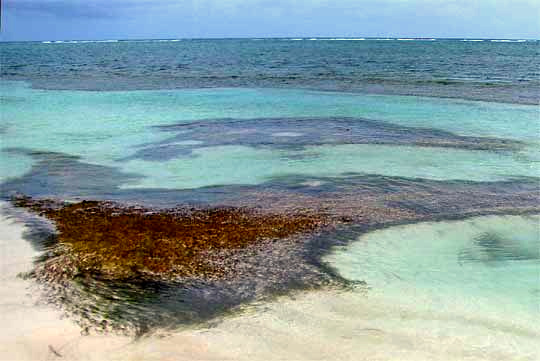
At low tide patches of seagrass close to shore may rise above all but the larger waves. When the water is lowest, often beautiful tropical fish shelter at the mats' edges and make brief forays across the shallow water above the mats. There are hours when thin sheets of clear water flow over the dark mats and the seagrass first points this way, then that way, depending on water flow direction, as below:
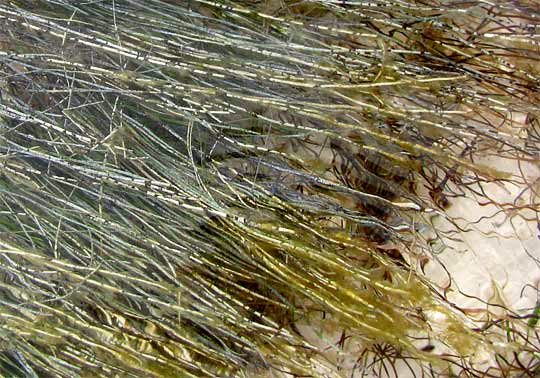
Best I can figure out, the fuzzy, greenish stuff at the bases of some of those slender stems is alga growing on the seagrass, while the whiteness covering the seagrass stems' top parts, mostly to the left, is carbonate gunk that chips off as the "grass" moves. Breaks in the pale gunk give the plant stems a segmented look, but the stems aren't segmented.
Based on technical literature and pictures on the Internet, this "grass" is Manatee-grass, SYRINGODIUM FILIFORME, not a grass at all but rather a member of the monocot Manateegrass Family, the Cymodoceaceae.
Ecologically an important thing about Manatee-grass is that its roots penetrate and stabilize offshore sand. Some landowners along this beach, wanting the turquoise water you see above naked, submerged, white sand, send workers out with machetes to uproot the Manatee-grass. They are encouraging the sea to wash away their beaches. The irregularly shaped, dark mats in the first picture stand about two feet above the naked sand surrounding them.
Right up the beach from here, for years a resort has systematically removed seagrass from before its beach. You can see a picture of the way that looks now below:
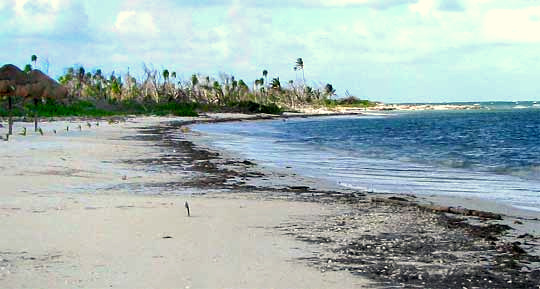
Ten years ago, I'm told, nearly all of the water you see in that picture was sandy beach with large Coconut Palms growing on it. It ran almost parallel with the rocky point seen at the distance. Beach erosion began immediately after removal of the seagrass began. The resulting little bay was already in place when Hurricane Dean came through last year.
Not only Manatee-grass but also the Turtle Grass, Thalassia testudinum, I told you about some Newsletters ago, host nitrogen-fixing anaerobic microbes on their roots and rhizomes, thus, like members of the Bean Family on dry land, in the sea these plants "fertilize" other aquatic plants in the area with usable nitrogen.
from the December 14, 2014 Newsletter issued from Río Lagartos, on the Yucatan Peninsula's northern coast (~N21.60°, ~W88.16°), Yucatán state, MÉXICO
MANATEE GRASS
Here on the Yucatan's north-central coast, the dominant seagrass on our muddy-bottomed Ría Lagartos Estuary's muddy floor is Shoalgrass, which we looked at last week, shown and described at www.backyardnature.net/yucatan/shoal-gr.htm.
However, in shallows offshore in the salty Gulf of Mexico itself, Shoalgrass gives way to Manatee Grass, SYRINGODIUM FILIFORME. During the last norte, or strong wind out of the north lasting for several days, enormous amounts of seaweed washed up on beaches, and most of the bulk of that seaweed was Manatee Grass. Below, you can see what a small part of the wash-up looked like:
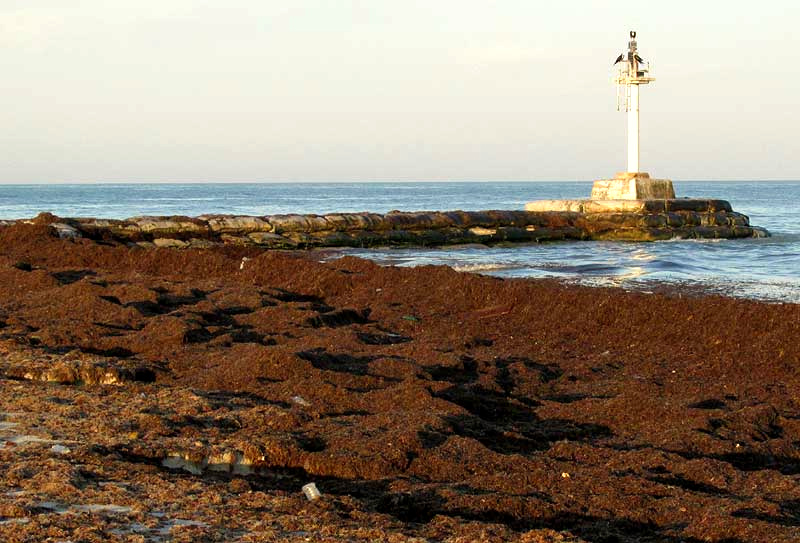
Inside the huge heap you could disentangle individual lengths of Manatee Grass rhizomes sprouting upward-directed, equally spaced stems along its length, with two or three cylindrical leaves issuing from each stem, as shown below:

At the base of each leaf there's a little ear, or "auricle," as shown below:
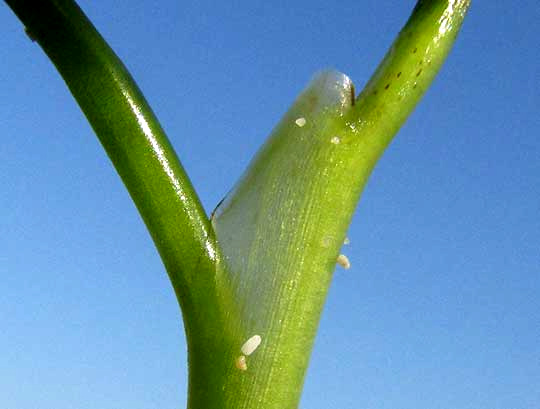
In that picture the leaf extends toward the picture's top, right corner, while the stem is directed toward the top, left. Note that the leaf base is round in cross-section, or cylindrical. That's an important feature, because at first glance Shoalgrass and Manatee Grass are very similar. However, Shoalgrass produces flat leaves, like those of a real grass, while Manatee Grass's leaves are cylindrical. Both Shoalgrass and Manatee Grass belong to the Manatee-Grass Family, the Cymodoceaceae, a small family whose members inhabit aquatic environments of the world's tropical and subtropical waters.
Manatee Grass occurs on submerged sand and mud of coastal areas surrounding the Gulf of Mexico and the Caribbean, south to northern South America.
In Florida, Manatee Grass is famous as Manatee food. Here on the Yucatan's northern coast at one time Manatees existed, and habitat for them -- extensive beds of Manatee Grass and Shoalgrass -- still exists, but apparently now Manatees are extinct in the Ría Lagartos Biosphere Reserve. Studies suggest that their disappearance was caused by hunting, drowning in fishermen's nets, and being injured by boat propellers.
Maybe someday Manatees will return here. From the amount of Manatee Grass washed upon beaches during the last norte, just offshore and in the estuaries, enormous underwater prairies of seagrass await them.